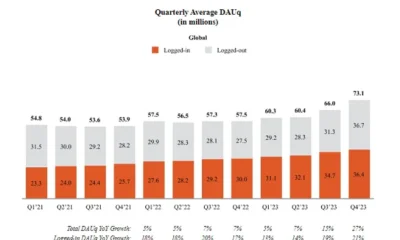SOCIAL
Meta Outlines its Approach to Election Security Ahead of the US Midterms

The US Midterms are coming up, and Meta has today outlined how it’s working to combat the spread of political misinformation within its apps, via a range of measures and awareness tools designed to help users make more informed choices about their votes in the upcoming polls.
As explained by Meta:
“Meta invests a huge amount to protect elections online – not just during election periods but at all times. We spent approximately $5 billion on safety and security last year alone, and have hundreds of people dedicated to this work permanently embedded across more than 40 teams. With each major election around the world – including national elections this year in France and the Philippines – we incorporate the lessons we learn to help stay ahead of emerging threats.”
Meta says that its approach to the 2022 US Midterms will incorporate learnings from its past efforts, and will entail a range of elements, including:
- Warning labels on fact-checked posts to help guide users to credible information around campaign claims
- An updated political ads Spend Tracker in its Ad Library Report, in order to help people understand how much specific candidates and political parties are spending to reach voters
- The prohibition of new political, electoral and social issue ads during the final week of the election campaign (the same as it implemented in the 2020 Presidential Election)
- Proactive efforts to remove misinformation about voting, as well as calls for violence related to voting, voter registration, or the administration or outcome of an election
- New voting participation stickers on Facebook and Instagram to encourage civic participation
Meta will also seek to highlight critical information about voter registration and state-based election updates.
“State and local election officials continue to use our Voting Alerts on Facebook to send the latest information about registering and voting to people in their communities, and there have been more than 80 million election-related notifications so far this year. We’re also elevating post Comments from local elections officials to ensure people have as much reliable information as possible about how, when and where to vote.”
And for the first time, Meta will also display election-related in-Feed notifications in a second language other than English, if it thinks the second language may be better understood.
“For example, if a person has their language set to English but is interacting with a majority of content in Spanish, then we will show the voting notifications in both English and Spanish.”
The measures will build on Meta’s existing fact-checking and misinformation tools to help solidify its approach to election integrity, and facilitate more accurate, informed discussion within its apps.
Meta has also published a new fact sheet outlining its various efforts on this front.

On another front, Meta also says that it’s taking stronger action on militant groups that seek to mobilize support via its platforms.
“We’ve banned more than 270 white supremacist organizations, and removed 2.5 million pieces of content tied to organized hate globally in the first quarter of 2022. Of the content we removed, nearly 97% of it was found by our systems before someone reported it.”
That’s become a key concern in the US, with the Capitol riots underlining the deep divides in American political discourse, which have been further worsened recently by the FBI raids on the home of former President Donald Trump.
Indeed, in the wake of the Mar-a-Lago raids, tensions are once again rising, with some suggesting that a civil war is brewing due to discontent over ideological viewpoints, which also links back to the Supreme Court’s recent ruling on abortion, controversies surrounding border protection, COVID mitigation measures, etc.
It’s an increasingly delicate situation, and no matter how you look at it, Facebook now plays a key role in the dissemination of news and information, with a third of US adults regularly accessing news content in the app.

Which is why Meta needs to take measures to ensure that it’s not amplifying false or misleading information.
Of course, critics would say that Meta should stay out of it, and let the people share the information that they deem to be accurate. But that’s simply not tenable, due to the incentives that digital platforms have inadvertently built into news coverage, which now unfairly skew outlets towards more divisive, partisan takes, as a means to maximize engagement.
Because what gets the most engagement? Content that sparks emotion, with ‘anger’ and ‘joy’ being the most effective triggers for prompting viral sharing.
As such, in order for news outlets to play into online algorithms, and maximize exposure for their websites, they need to focus on these elements, which is why you see so many extreme, almost absurd takes from media commentators every day – because they know that these comments will get people talking, thereby boosting their CTR, and making them more money from ads.
It’s often not ideology, it’s business, and it makes businesses sense, in the current landscape, to be provocative, to poke people based on their beliefs, and get them to react, in the form of more engagement.
But as we’ve seen, the flow-on impacts of that can be significant, leading to unjust decisions, flawed institutional responses, and actual, real world violence as a result of such trends.
It’s not just words, these are not just opinions that people can just shrug off as such so easily. Enabling the amplification of these movements can lead to significant harm, which is why Meta, and all social platforms, need to take responsibility for their role in such, through assessment of how they may be unfairly influencing political opinions.
You can check out Meta’s full midterms fact sheet here.
SOCIAL
Snapchat Explores New Messaging Retention Feature: A Game-Changer or Risky Move?

In a recent announcement, Snapchat revealed a groundbreaking update that challenges its traditional design ethos. The platform is experimenting with an option that allows users to defy the 24-hour auto-delete rule, a feature synonymous with Snapchat’s ephemeral messaging model.
The proposed change aims to introduce a “Never delete” option in messaging retention settings, aligning Snapchat more closely with conventional messaging apps. While this move may blur Snapchat’s distinctive selling point, Snap appears convinced of its necessity.
According to Snap, the decision stems from user feedback and a commitment to innovation based on user needs. The company aims to provide greater flexibility and control over conversations, catering to the preferences of its community.
Currently undergoing trials in select markets, the new feature empowers users to adjust retention settings on a conversation-by-conversation basis. Flexibility remains paramount, with participants able to modify settings within chats and receive in-chat notifications to ensure transparency.
Snapchat underscores that the default auto-delete feature will persist, reinforcing its design philosophy centered on ephemerality. However, with the app gaining traction as a primary messaging platform, the option offers users a means to preserve longer chat histories.
The update marks a pivotal moment for Snapchat, renowned for its disappearing message premise, especially popular among younger demographics. Retaining this focus has been pivotal to Snapchat’s identity, but the shift suggests a broader strategy aimed at diversifying its user base.
This strategy may appeal particularly to older demographics, potentially extending Snapchat’s relevance as users age. By emulating features of conventional messaging platforms, Snapchat seeks to enhance its appeal and broaden its reach.
Yet, the introduction of message retention poses questions about Snapchat’s uniqueness. While addressing user demands, the risk of diluting Snapchat’s distinctiveness looms large.
As Snapchat ventures into uncharted territory, the outcome of this experiment remains uncertain. Will message retention propel Snapchat to new heights, or will it compromise the platform’s uniqueness?
Only time will tell.
SOCIAL
Catering to specific audience boosts your business, says accountant turned coach

While it is tempting to try to appeal to a broad audience, the founder of alcohol-free coaching service Just the Tonic, Sandra Parker, believes the best thing you can do for your business is focus on your niche. Here’s how she did just that.
When running a business, reaching out to as many clients as possible can be tempting. But it also risks making your marketing “too generic,” warns Sandra Parker, the founder of Just The Tonic Coaching.
“From the very start of my business, I knew exactly who I could help and who I couldn’t,” Parker told My Biggest Lessons.
Parker struggled with alcohol dependence as a young professional. Today, her business targets high-achieving individuals who face challenges similar to those she had early in her career.
“I understand their frustrations, I understand their fears, and I understand their coping mechanisms and the stories they’re telling themselves,” Parker said. “Because of that, I’m able to market very effectively, to speak in a language that they understand, and am able to reach them.”Â
“I believe that it’s really important that you know exactly who your customer or your client is, and you target them, and you resist the temptation to make your marketing too generic to try and reach everyone,” she explained.
“If you speak specifically to your target clients, you will reach them, and I believe that’s the way that you’re going to be more successful.
Watch the video for more of Sandra Parker’s biggest lessons.
SOCIAL
Instagram Tests Live-Stream Games to Enhance Engagement

Instagram’s testing out some new options to help spice up your live-streams in the app, with some live broadcasters now able to select a game that they can play with viewers in-stream.
As you can see in these example screens, posted by Ahmed Ghanem, some creators now have the option to play either “This or That”, a question and answer prompt that you can share with your viewers, or “Trivia”, to generate more engagement within your IG live-streams.
That could be a simple way to spark more conversation and interaction, which could then lead into further engagement opportunities from your live audience.
Meta’s been exploring more ways to make live-streaming a bigger consideration for IG creators, with a view to live-streams potentially catching on with more users.
That includes the gradual expansion of its “Stars” live-stream donation program, giving more creators in more regions a means to accept donations from live-stream viewers, while back in December, Instagram also added some new options to make it easier to go live using third-party tools via desktop PCs.
Live streaming has been a major shift in China, where shopping live-streams, in particular, have led to massive opportunities for streaming platforms. They haven’t caught on in the same way in Western regions, but as TikTok and YouTube look to push live-stream adoption, there is still a chance that they will become a much bigger element in future.
Which is why IG is also trying to stay in touch, and add more ways for its creators to engage via streams. Live-stream games is another element within this, which could make this a better community-building, and potentially sales-driving option.
We’ve asked Instagram for more information on this test, and we’ll update this post if/when we hear back.
-

 WORDPRESS7 days ago
WORDPRESS7 days ago10 WordPress Influencers to Follow in 2024 – WordPress.com News
-

 MARKETING7 days ago
MARKETING7 days agoFeeling Stuck: What to Do When You Don’t Know What to Do
-

 PPC6 days ago
PPC6 days agoCompetitor Monitoring: 7 ways to keep watch on the competition
-

 PPC5 days ago
PPC5 days agoA History of Google AdWords and Google Ads: Revolutionizing Digital Advertising & Marketing Since 2000
-

 WORDPRESS6 days ago
WORDPRESS6 days agoThrive Architect vs Divi vs Elementor
-

 SEARCHENGINES6 days ago
SEARCHENGINES6 days agoMore Google March 2024 Core Update Ranking Volatility
-

 PPC6 days ago
PPC6 days ago31 Ready-to-Go Mother’s Day Messages for Social Media, Email, & More
-

 WORDPRESS5 days ago
WORDPRESS5 days agoTurkish startup ikas attracts $20M for its e-commerce platform designed for small businesses















You must be logged in to post a comment Login